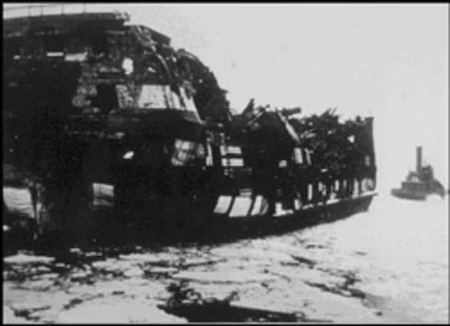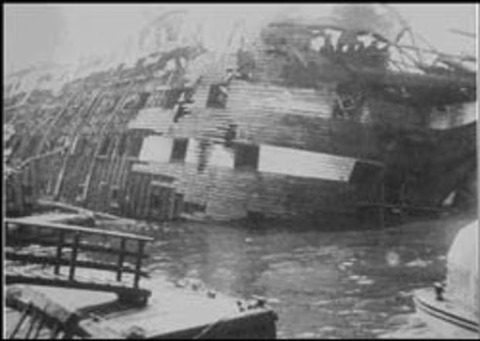BUAR classifies certain shipwrecks and other underwater archaeological resources as "Exempted Sites" for a variety of reasons, including (but not limited to): commonly known location, previous salvage, recreational value, educational value, or lack of significant archaeological or historical value. Recreational diving activities on these sites, including casual artifact collection, do not require a BUAR permit. However, any major disruption of the site is prohibited. The intent of creating an exempted shipwreck site is to preserve such sites for the continued enjoyment of the recreational diving community, who is encouraged to protect these sites for the continued enjoyment of all.
Note: All dives are conducted at your own risk. The Commonwealth of Massachusetts accepts no responsibility for loss of any kind, including personal injury or property damage. The Commonwealth of Massachusetts assumes no liability for inaccuracies in dive information contained in these pages including site locations and dive conditions.
Vessel Details
Massachusetts after second fire in 1922. Photo courtesy of BUAR.
Description: warship, ship-of-the-line.
Dimensions: length - 196.3 ft. width - 53 ft. depth - 25.6 ft.
Tonnage: gross - 2,600.
Propulsion: sail, square-rigged, 3 masts.
The Shipwreck
Date Sunk: July 27, 1922.
Cause: fire.
Location: Graves Island, Manchester-by-the-Sea.
Coordinates: latitude 42° 34' 16" N; longitude 70° 44' 45" W.
While this vessel was in tow of the tug Perth Amboy, five days out of New York City, a fire of undetermined origin broke out aboard the old ship-of-the-line. The third fire in the warship's history started around 10AM and spread quickly. No sooner had the two-man crew abandoned ship, than the towline parted from the flaming bow and the USS Granite State was adrift. Smoke could be seen for miles, but those witnessing the conflagration from shore knew not what vessel burned off their coast. The ship burned fiercely all day, preventing the Perth Amboy from securing a new towline or even fighting the fire. At midnight, observers on shore saw the flames suddenly go out. The warship had fetched atop the granite shoals on the southwest corner of Graves Island where beyond recovery, the vessel was left to the mercy of the elements.
Photo courtesy of BUAR.
A year earlier, on May 23, 1921 the Granite State was severely damaged by fire, while tied to the 96th Street Pier in New York City. Oil, pooling around the ship from a leaking six-inch Standard Oil Company pipe, was ignited from the backfire of a passing captain's gig. The resulting fire, aggravated by low water pressure on shore, destroyed the gig, a three-story naval office, storehouse and the Granite State. Before the crew abandoned ship, it flooded the vessel's powder magazine, preventing an explosion that would have devastated the surrounding area. Fireboats pumped tons of water into the flaming hulk until it settled into the mud. Listing sharply to port, the vessel was kept from capsizing only by its mooring chains.
In August 1921, the burned out hulk of the U.S.S. Granite State was sold at auction for $5,000. It was estimated that $70,000 of salvageable material could be removed from the wreckage, which was fastened and sheathed with over 100 tons of copper. Two five-ton anchors, along with 100 tons of chain, were still aboard the vessel. Also, it was rumored that the ship's keel contained three gold spikes. Thus, a five month salvage operation was undertaken after which the lower gun ports were sealed with canvas patches, the water pumped out and the old warrior was taken in tow for Eastport, Maine, where it was to be broken up.
Historical Background
Constructed: in 1816-1864 at Portsmouth, New Hampshire by the Portsmouth Navy Yard.
Construction details: built of live oak with copper fastenings believed to have been forged at the Revere Foundry, established by Paul Revere. Fittings are identical to Revere fittings utilized in smaller frigate.
Owners: Mulholland Machinery, Corporation, New York.
Home or Hailing Port: New York.
Former Name(s) and date(s): Alabama (1816-1864), New Hampshire (1864-1904), Granite State (1904-1922).
Official number:Country: U.S.A.
Other Comments
1816 - April 29, the United States Congress authorized funding for nine 74-gun ships-of-the-line.
1818 - Commissioned as the Alabama in presence of President James Monroe.
1825 - Nearly completed, but remained on stocks at the Portsmouth Navy Yard.
1864 - April 23, launched for service in the Civil War, name changed from Alabama to New Hampshire.
1864 - 1866 - Served off Port Royal, South Carolina as a hospital and supply ship.
1866 - June 8, Norfolk, Virginia, began service as a receiving ship.
1876 - April 10, returned to Port Royal.
1881 - Reassigned to Norfolk, Virginia for use as a receiving ship and then to New Port, Rhode Island for use as flagship of the Apprentice Training Squadron.
1893 - Loaned to the New York State Naval Militia as a training ship and armory. Nearly one thousand men who trained aboard the old ship-of-the-line served in the Spanish American War.
1904 - November 30, name changed to Granite State so that New Hampshire could be used for a new battleship.
1918 - Fire broke out in the forecastle and spread to throughout the superstructure. Disaster averted by crew flooding ship's magazine.
1921 - April 23, fire destroyed the warship at the dock.
Salvage
Three savage operations recovered huge oak timbers from the wreck for the copper with which they were fastened. Over the years, one of New Hampshire's anchors and numerous cannon balls have reportedly been recovered.
The November 2, 1965 edition of the Boston Globe reports that Norwood resident William Kolb planned on recovering artifacts from the vessel while he was manning the "Aqua Cabin" underwater habitat, which was placed in 80 feet of water a short distance form the wreck site by the Hektor Scientific Company of Foxboro, Massachusetts.
Sources
Boston Globe; November 2, 1965
New England's Legacy of Shipwrecks; Keatts, 1988
New York Times; April 24, 1921
New York Times; July 27, 1922
New York Times; November 2, 1965

